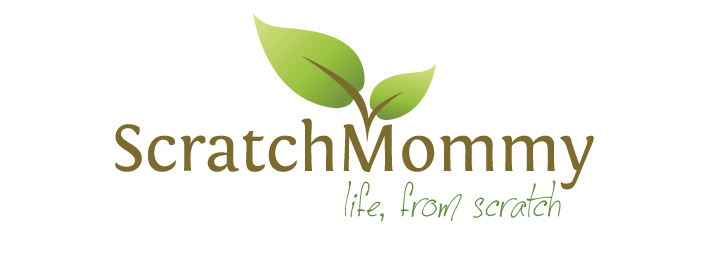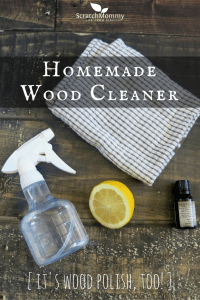Kids and nice stuff don’t mix. I mean, like not at all. When I was expecting my first child, we were gifted an amazing highchair that is made of beautiful solid wood and pulls right up to the table. I loved it because it meant our little ones could eat with us at the table instead of being stuck all by themselves in a highchair with a plastic tray.
…I now get why the plastic trays exist.
With our highchair, our little ones have to eat their food directly on the table which makes such a mess that I have to clean the table multiple times a day. I tried putting placemats down (which are promptly thrown to the floor), only offering food on plates or in bowls (the food never stays in them), and even tried only offering non-messy foods (infants can make anything a sticky mess). Nothing worked, so eating straight off the table was the only option.
Between art projects, starting seedlings, mealtimes, and other activities that surround our table, it gets pretty messy and needs to be cleaned…often. But the more I clean the table with soap, the more worn the wood looks. Wood cleaners and polishes work great for restoring the wood, but they’re often quite toxic. Take, for example, this one which is commonly used in homes and receives a grade of F from the EWG…yuck.
Now that my youngest is nearing 2 she is much better about using a placemat and eating from a plate. That said, there is still plenty of food that gets chewed up, placed on the wood table, and often chewed again! Since my toddler still eats right off the table it’s especially concerning what might be in the wood polish (and subsequently, going into her food and then her body).
So, into the kitchen I went where I developed this homemade wood cleaner recipe. It is safe, natural, and really works to both clean and condition wood.
- ½ C White Vinegar (just plain old white vinegar, or you can use ACV for darker woods, if you like)
- ¼ C Olive Oil (organic, extra virgin olive oil)
- 1 tbsp Lemon Juice
- 1 tbsp Vegetable Glycerin (optional, but a really great addition - non-GMO, organic vegetable glycerin)
- 20-30 drops Lavender Essential Oil (organic lavender essential oil)
-
Mix all ingredients in a glass spray bottle. Shake well before each use.
-
Spray on wood and rub with microfiber or other soft cloth.
How Does It Work?
Each ingredient has it’s own part in making this recipe both safe and effective. So, let’s dig into and dissect the ingredients in this homemade wood cleaner recipe…
Olive Oil
Olive oil shines, moisturizes, and protects wood. Many people use mineral oil instead of olive oil, but I choose not to. Mineral oil is a petroleum product so it’s not natural or sustainable. Mineral oil does last longer than olive oil, but making smaller batches of this homemade wood cleaner can fix that problem easily. Learn more about different carrier oils that you could use in this recipe.
White Vinegar (or ACV)
Vinegar cuts through the greasy, grimy, yuckiness that gets stuck to the table after meals. It’s also mildly disinfecting. If you use this on dark woods apple cider vinegar is a great option.
Lemon Juice
Also a mild disinfectant, lemon juice adds a nice fresh scent to your new homemade wood cleaner.
Vegetable Glycerin
Vegetable glycerin helps make wood shine and keeps the wood keep the shine longer. Although vegetable glycerin is optional in this recipe, I highly recommend it. In fact, Scratch Mommy Founder Jess uses vegetable glycerin in many of her DIY recipes.
Lavender Essential Oil
Lavender and lemon juice are a fantabulous combination for a subtle clean scent.
Caring For Wood Furniture
Knowing the finish of your wood is important in deciding how to care for the table. Many tables manufactured recently are a hard surfaced wood finish so you can use this recipe as often as you like.
Oil and wax finished tables need a more gentle cleaning routine. Usually just a simple soft cloth can remove dust and debris, while you should wet it for tougher messes.
Our table is an oiled wood table. Dusting gently with a damp cloth is usually enough, but since I have to scratch dried food off of it often(!), I have to do a little more. I use this recipe to clean the table and if the wood looks worn afterwards I add some pure olive oil and let it soak into the wood.
This safe, non-toxic recipe is so easy to make and I bet you have all of the ingredients laying around already!



Comments 36
I borrowed from this recipe, but substituted refractionated coconut oil, and added beeswax. Thanks for the breakdown of ingredients!
I used the olive oil, vinegar and lemon juice solution. Didn’t have the other ingredients. I used on 60 year old bookends and wife and I were shocked at the way it brought the wood out. Beautiful. Thanks!
Oh wow…60 years old? That’s incredible! Thanks so much for sharing. Hooray for easy non-toxic DIY solutions!
How long is the shelf life for this? Does it need to be kept in the fridge? Does it require a preservative? Just wondering with the juice in it, thank you for your time.
Hi Joyce! Lemon juice might taste bad after a couple of weeks, but it’s actually still good and just fine for cleaning. It’s high acidic content makes it a great cleaner and helps keep it shelf stable. The shelf life will be based on the shelf life of the carrier oil you use. Happy DIYing!
Hello. I would like to know if this homemade wood cleaner works on (sort of) antique wood? It’s a small end table and decorative hand carved quail from the 1960’s or 1970’s that I need cleaned. Thank you.
I would patch test a small area and see how it does first, and perhaps check with an antique dealer would is familiar with that particular type of wood.
I used this for cleaning the stainless steel appliances and it worked great on those as well. Thank you!
Oh wow…that’s great to hear. I will have to give this a try. Thanks for sharing!
If I were to use Lemon essential oil instead of the lemon juice, how many drops would I use? Can’t add lavender at all. Hubby’s allergic. I can add tea tree oil.
I would start with a 1% ratio. Hope this helps!
Does this have a shelf life by chance? I have never used real lemon just essential oils in my DIY cleaners. Thank you in advance!
The shelf life would be the shelf life of the carrier oil you choose to use. You can learn more about carrier oils here on my sister site, Pronounce Skincare.
Don’t veggie/food oils go rancid and smell after a while? The smell of stale oil is rather unpleasant and when I bought a natural wood cutting board they said not to use veggie oils for this reason….?
I actually use either olive oil or avocado oil on my cutting boards (I’m not a fan of super processed mineral oil). I’ve had zero issues with any funny smell on any of my wood surfaces…perhaps the essential oils help? I think you’ll be pleasantly surprised.
“Veggie oils” are highly refined and terribly unhealthy for everyone. Healthy fats/oils work great on wood. I use plain, straight coconut oil on all my cutting boards to keep them seasoned and sealed.
With no residual smells whatsoever.
Works great! Thank you.
I already work with chemicals- I don’t want them dominating my home.
If people only read the SDS’s!
what is good to clean wood cabints with
This wood polish/cleaner recipe would work great for your needs!
Love the wood polish/cleaner. I am already on my second batch. Thank you.
Hooray! I’m glad that you love it, too. So easy and effective…for the win! 🙂
Hey! I loved this. I made this homemade wood cleaner to prep a piece I featured on my blog. It worked so well. I don’t think I used quite enough essential oil because the vinegar smell was so overpowering, but I don’t mind vinegar. Thank you for posting this recipe!
I’m glad you like this recipe, too! Yes, yes…customize away with this one, adding whatever antibacterial kind of EOs you like. Happy DIYing and healthy cleaning!
I’m looking for a better wood cleaner – look forward to trying this out!
I think you’ll really love it!
Thank you for this recipe. I used it on the wood on a 50+ yr old mirror and a 100+ yr old treadle sewing machine and the wood just glowed and looked so good.
I am going to make this. I am inspired by all of the great feedback!
DIY at home with no chemicals = always better if it works! Sounds like this does!!
Yes, the feedback is great. It’s a staple in my home. I think you’ll love it, too. 🙂
I love it! I added lots and lots of rose oil because personally I like rose and the vinegar was overwleming to me. like the results so much!!
Oh, I’m sure it smells amazing. SO glad you love it, too!
Can you use this on hardwood floors?
Yes you can!
I made this with water and thieves cleaner instead, then just added the olive oil but it’s separating. Is it the water?
Hi Carly! Yes, water and oil don’t mix. We don’t recommend using water in your wood cleaner because it will be more drying than nourishing for your wood.
I am anxious to try this but wonder what would happen if I used a plastic spray bottle instead of a glass one. ???
Hi Carol! Generally speaking, it is best to keep recipes with essential oils in glass and some metal containers. Over time, essential oils can break down plastic. That said, it takes a while and if you plan to use this up fairly quickly here are the best plastics to use, if you must use plastic: HDPE plastic (High Density Polyethylene), #1 plastic, #2 plastic, &/or thick food grade plastic. I hope this helps. Happy DIYing!